Inhibition Effect of Hydrophobic Functional Organic Corrosion Inhibitor in Reinforced Concrete
Abstract
1. Introduction
2. Materials and Methods
2.1. Materials
2.2. Sample Preparations
2.3. Methods
2.3.1. Pore Structure Analysis
2.3.2. Contact Angle Measurement
2.3.3. Capillary Water Absorption Test
2.3.4. Characterization of Adsorption Amount of Hydrophobic Functional Organic Corrosion Inhibitor
2.3.5. Electrochemical Behavior of Reinforced Concrete
3. Results and Discussions
3.1. Effect of Hydrophobic Functional Organic Corrosion Inhibitor on Pore Structure of Cement Paste
3.2. Effect of Hydrophobic Functional Corrosion Inhibitor on Contact Angle of Cement-Based Materials
3.3. Effect of Hydrophobic Functional Corrosion Inhibitor on Capillary Water Absorption Amount of Cement-Based Materials
3.4. Adsorption Amount of Hydrophobic Functional Organic Corrosion Inhibitor
3.5. Effect of Hydrophobic Functional Corrosion Inhibitor on Electrochemical Behavior of Reinforced Concrete
3.5.1. OCP of the Reinforcement Embedded in Concrete
3.5.2. EIS of the Reinforcement Embedded in Concrete
3.5.3. PD Results of the Reinforcement Embedded in Concrete
3.5.4. Discussions
4. Conclusions
Author Contributions
Funding
Institutional Review Board Statement
Informed Consent Statement
Data Availability Statement
Conflicts of Interest
References
- Broomfield, J.P. Corrosion of Steel in Concrete Understanding, Investigation and Repair, 1st ed.; CRC Press: London, UK, 1996. [Google Scholar]
- Bertolini, L.; Elsener, B.; Pedeferri, P.; Redaelli, E.; Polder, R. Corrosion of Steel in Concrete—Prevention, Diagnosis, Repair, 2nd edn Book review. Mag. Concr. Res. UK 2015, 67, 107. [Google Scholar]
- Welle, A.; Liao, J.D.; Kaiser, K.; Grunze, M.; Mäder, U.; Blank, N. Interactions of N,N′-dimethylaminoethanol with steel surfaces in alkaline and chlorine containing solutions. Appl. Surf. Sci. 1997, 119, 185–198. [Google Scholar] [CrossRef]
- Wei, J.; Dong, J.H.; Ke, W. Corrosion resistant performance of a chemical quenched rebar in concrete. Constr. Build. Mater. 2010, 25, 1243–1247. [Google Scholar] [CrossRef]
- Palomar-Pardavé, M.; Romero-Romo, M.; Herrera-Hernández, H.; Abreu-Quijano, M.A.; Likhanova, N.V.; Uruchurtu, J.; Juárez-García, J.M. Influence of the alkyl chain length of 2 amino 5 alkyl 1,3,4 thiadiazole compounds on the corrosion inhibition of steel immersed in sulfuric acid solutions. Corros. Sci. 2012, 54, 231–243. [Google Scholar] [CrossRef]
- Ormellese, M.; Lazzari, L.; Goidanich, S.; Fumagalli, G.; Brenna, A. A study of organic substances as inhibitors for chloride-induced corrosion in concrete, Corros. Sci. 2009, 51, 2959–2968. [Google Scholar]
- Pareek, S.; Jain, D.; Hussain, S.; Biswas, A.; Shrivastava, R.; Parida, S.K.; Kisan, H.K.; Lgaz, H.; Chung, I.M.; Behera, D. A new insight into corrosion inhibition mechanism of copper in aerated 3.5 wt.% NaCl solution by eco-friendly Imidazopyrimidine Dye: Experimental and theoretical approach. Chem. Eng. J. 2019, 358, 725–742. [Google Scholar] [CrossRef]
- Ryu, H.S.; Singh, J.K.; Yang, H.M.; Lee, H.S.; Ismail, M.A. Evaluation of corrosion resistance properties of N, N′-Dimethyl ethanolamine corrosion inhibitor in saturated Ca(OH)2 solution with different concentrations of chloride ions by electrochemical experiments. Constr. Build. Mater. 2016, 114, 223–231. [Google Scholar] [CrossRef]
- Söylev, T.A.; Richardson, M.G. Corrosion inhibitors for steel in concrete: State of-the-art report. Constr. Build. Mater. 2008, 22, 609–622. [Google Scholar] [CrossRef]
- Wang, Y.; Zuo, Y. The adsorption and inhibition behavior of two organic inhibitors for carbon steel in simulated concrete pore solution. Corros. Sci. 2017, 118, 24–30. [Google Scholar] [CrossRef]
- Pradipta, I.; Kong, D.; Tan, J.B.L. Natural organic antioxidants from green tea form a protective layer to inhibit corrosion of steel reinforcing bars embedded in mortar. Constr. Build. Mater. 2019, 221, 351–362. [Google Scholar] [CrossRef]
- Hu, J.; Cheng, X.; Li, X.; Deng, P.; Wang, G. The coupled effect of temperature and carbonation on the corrosion of rebars in the simulated concrete pore solutions. J. Chem. 2015, 2015, 1–6. [Google Scholar] [CrossRef]
- Jamil, H.E.; Montemor, M.F.; Boulif, R.; Shriri, A.; Ferreira, M.G.S. An electrochemical and analytical approach to the inhibition mechanism of an amino-alcohol-based corrosion inhibitor for reinforced concrete. Electrochim. Acta 2003, 48, 3509–3518. [Google Scholar] [CrossRef]
- Zhou, Y.; Cai, J.; Hou, D.; Chang, H.L.; Yu, J. The inhibiting effect and mechanisms of smart polymers on the transport of fluids throughout nano-channels. Appl. Surf. Sci. 2020, 500, 144019. [Google Scholar] [CrossRef]
- Shen, L.; Jiang, H.; Cao, J.; Zhang, H. The effect of electro-migrating 3-Aminopropyltriethoxysilane on the improvement of the reinforced concrete durability. Constr. Build. Mater. 2019, 214, 101–110. [Google Scholar] [CrossRef]
- Khaled, A.; Mohammed, M.; Omar, S.; Tawfik, A. Efficiency of generic and proprietary inhibitors in mitigating Corrosion of Carbon Steel in Chloride-Sulfate Environments. Sci. Rep. 2018, 8, 11443. [Google Scholar]
- Zhao, Y.; Pan, T.; Yu, X.; Chen, D. Corrosion inhibition efficiency of triethanolammonium dodecylbenzene sulfonate on Q235 carbon steel in simulated concrete pore solution. Corrs. Sci. 2019, 158, 108097. [Google Scholar] [CrossRef]
- Fei, F.L.; Hu, J.; Wei, J.X.; Yu, Q.J.; Chen, Z.S. Corrosion performance of steel reinforcement in simulated concrete pore solutions in the presence of imidazoline quaternary ammonium salt corrosion inhibitor. Constr. Build. Mater. 2014, 70, 43–53. [Google Scholar] [CrossRef]
- Cai, J.S.; Liu, J.P.; Shi, L.; Liu, J.Z.; Mu, S. The influence of a newly organic inhibitor on corrosion resistance of reinforcing steel and concrete. In Proceedings of the 37th Cement and Concrete Science Conference, London, UK, 11–12 September 2017. [Google Scholar]
- Diamanti, M.V.; Rosales, E.A.P.; Raffaini, G.; Ganazzoli, F.; Brenna, A.; Pedeferri, M. Molecular modelling and electrochemical evaluation of organic inhibitors in concrete. Corros. Sci. 2015, 100, 231–241. [Google Scholar] [CrossRef]
- Washburn, E.W. The dynamics of capillary flow. Phys. Rev. 1921, 17, 273–283. [Google Scholar] [CrossRef]
- Castro, J.; Bentz, D.; Weiss, J. Effect of sample conditioning on the water absorption of concrete. Cem. Concr. Compos. 2011, 33, 805–813. [Google Scholar] [CrossRef]
- Poursaee, A.; Hansson, C.M. Potential pitfalls in assessing chloride-induced corrosion of steel in concrete. Cem. Concr. Res. 2009, 39, 391–400. [Google Scholar] [CrossRef]
- Yohai, L.; Vázquez, M.; Valcarce, M.B. Phosphate ions as corrosion inhibitors for reinforcement steel in chloride-rich environments. Electrochim. Acta. 2013, 102, 88–99. [Google Scholar] [CrossRef]
- Huang, J.; Li, Z.; Liaw, B.Y.; Zhang, J. Graphical analysis of electrochemical impedance spectroscopy data in Bode and Nyquist representations. J. Power. Sources 2016, 309, 82–98. [Google Scholar] [CrossRef]
- Córdoba-Torres, P.; Mesquita, T.J.; Devos, O.; Tribollet, B.; Roche, V.; Nogueira, R.P. On the intrinsic coupling between constant-phase element parameters α and Q in electrochemical impedance spectroscopy. Electrochim. Acta 2012, 72, 172–178. [Google Scholar] [CrossRef]
- Zahraa, A.; Abdulrasoul, S.; Shaker, S. Reed Leaves Extract as Corrosion Inhibitor for Reinforcing Steel in Concrete. IOP Conf. Ser. Mater. Sci. Eng. 2020, 871, 012003. [Google Scholar]
- Wang, W.; Song, Z.; Guo, M.; Jiang, L.; Xiao, B.; Jiang, G.; Chu, H.; Liu, Y.; Zhang, Y.; Xu, N. Employing ginger extract as an eco-friendly corrosion inhibitor in cementitious materials. Constr. Build. Mater. 2019, 228, 116713. [Google Scholar] [CrossRef]
- Mohammad, A.; Mohammad, I.; Mahmood, M.; Ghasan, F.; Pandian, B.; Yuli, P. Enhanced corrosion resistance of reinforced concrete: Role of emerging eco-friendly Elaeis guineensis/silver nanoparticles inhibitor. Constr. Build. Mater. 2018, 188, 555–568. [Google Scholar]
- Shen, L.; Jiang, H.; Cao, J.; Zhang, M.; Zhang, H. A comparison study of the performance of three electro-migrating corrosion inhibitors in improving the concrete durability and rehabilitating decayed reinforced concrete. Constr. Build. Mater. 2020, 238, 117673. [Google Scholar] [CrossRef]
- Nahida, N.; Javed, A. Experimental investigation of Rice Husk Ash on compressive strength, carbonation and corrosion resistance of reinforced concrete. Aust. J. Civ. Eng. 2021, 19, 155–163. [Google Scholar]
- Shaymaa, A.; Éva, F.; Tamás, I. Corrosion testing on steel reinforced XD3 concrete samples prepared with a green inhibitor and two different superplasticizers. Mater. Corros. 2019, 70, 1262–1272. [Google Scholar]
- Hang, M.; Jiang, M.; Xu, J.; Cheng, T.; Wang, H.; Zhou, G. The electrochemical performance and modification mechanism of the corrosion inhibitor on concrete. Sci. Eng. Compos. Mater. 2021, 28, 352–362. [Google Scholar] [CrossRef]
- Ahmed, E.; Stéphanie, B.; Abdelhafid, K.; Mohammad, F. Performance of chemical substance inhibitors on the surface between steel rebar and concrete. Eur. J. Environ. Civ. Eng. 2021, 2003251. [Google Scholar] [CrossRef]
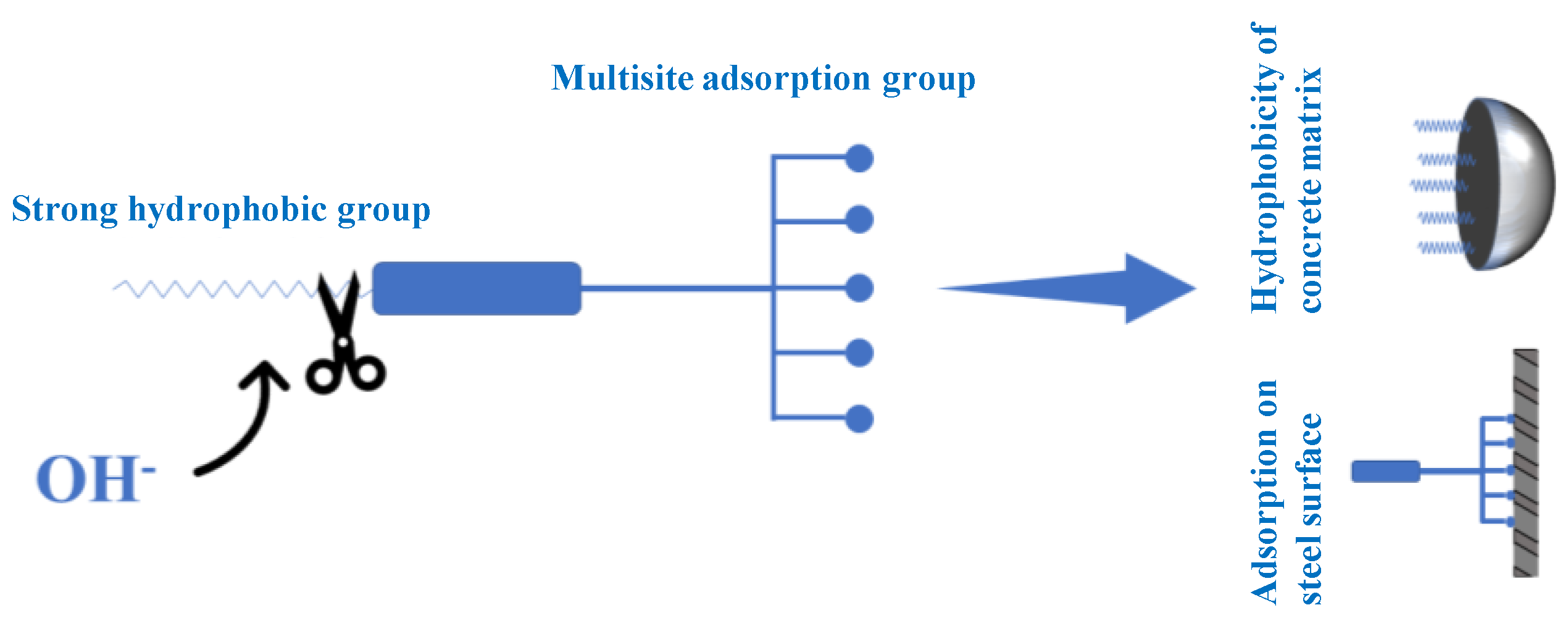
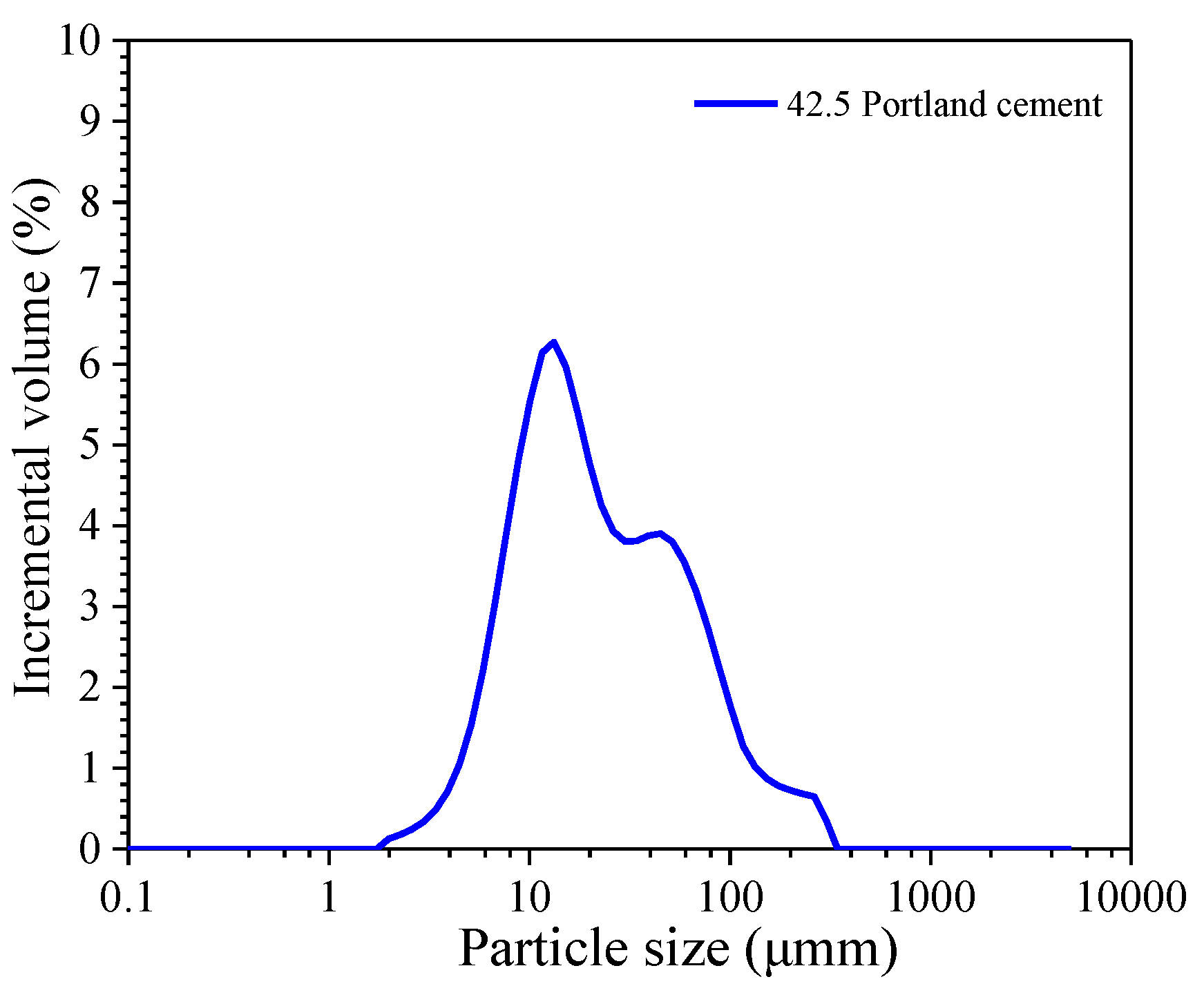
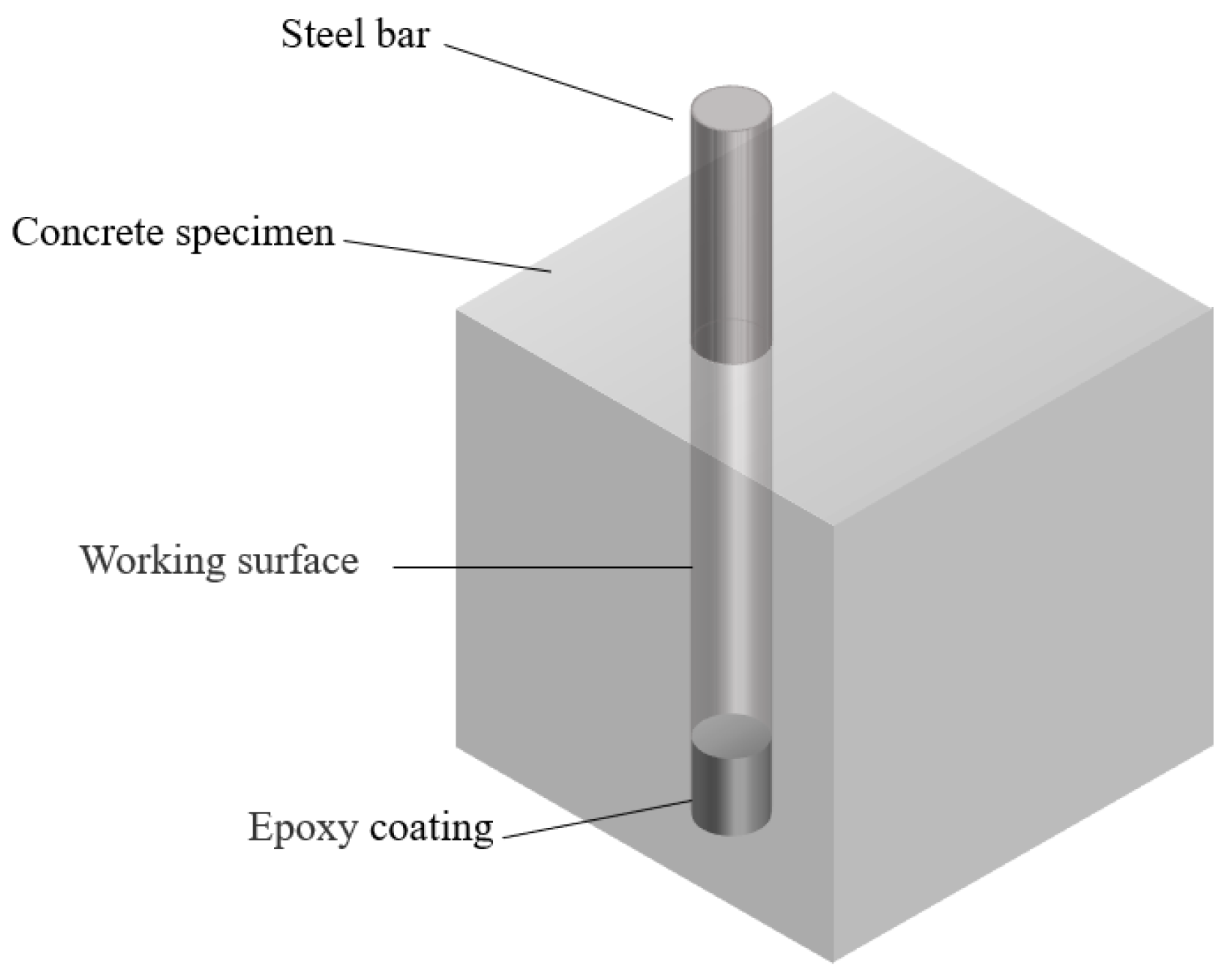
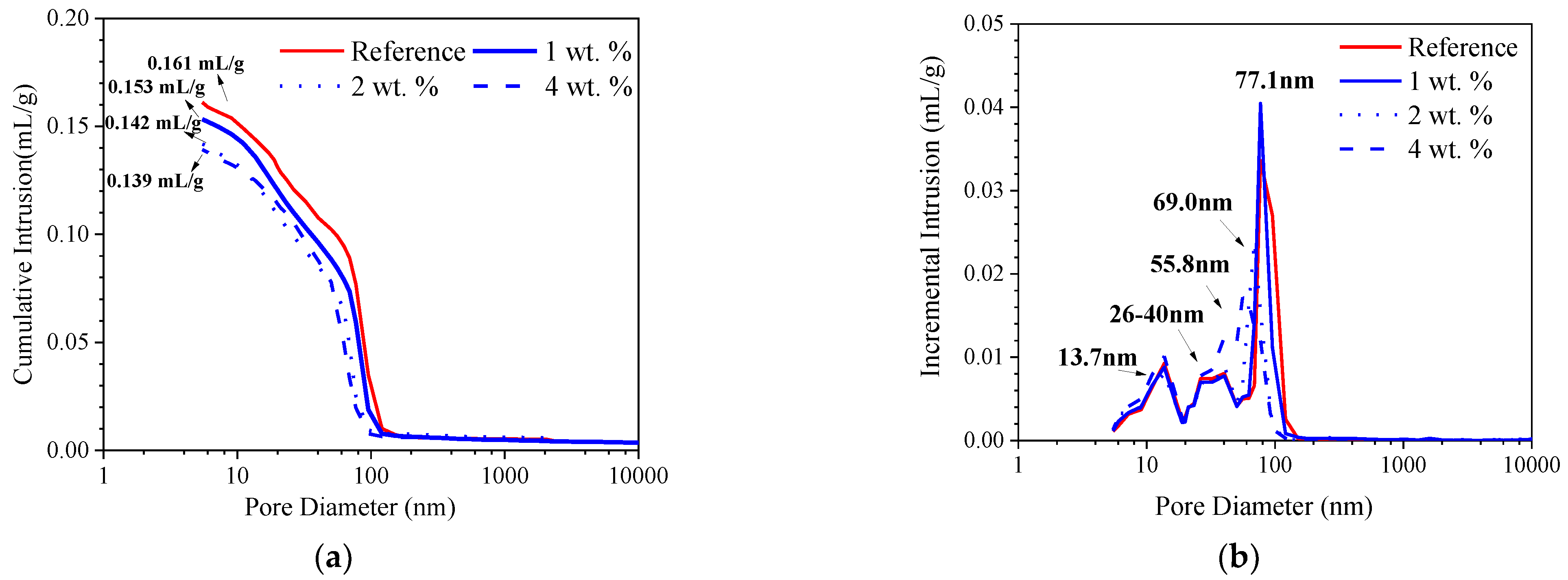
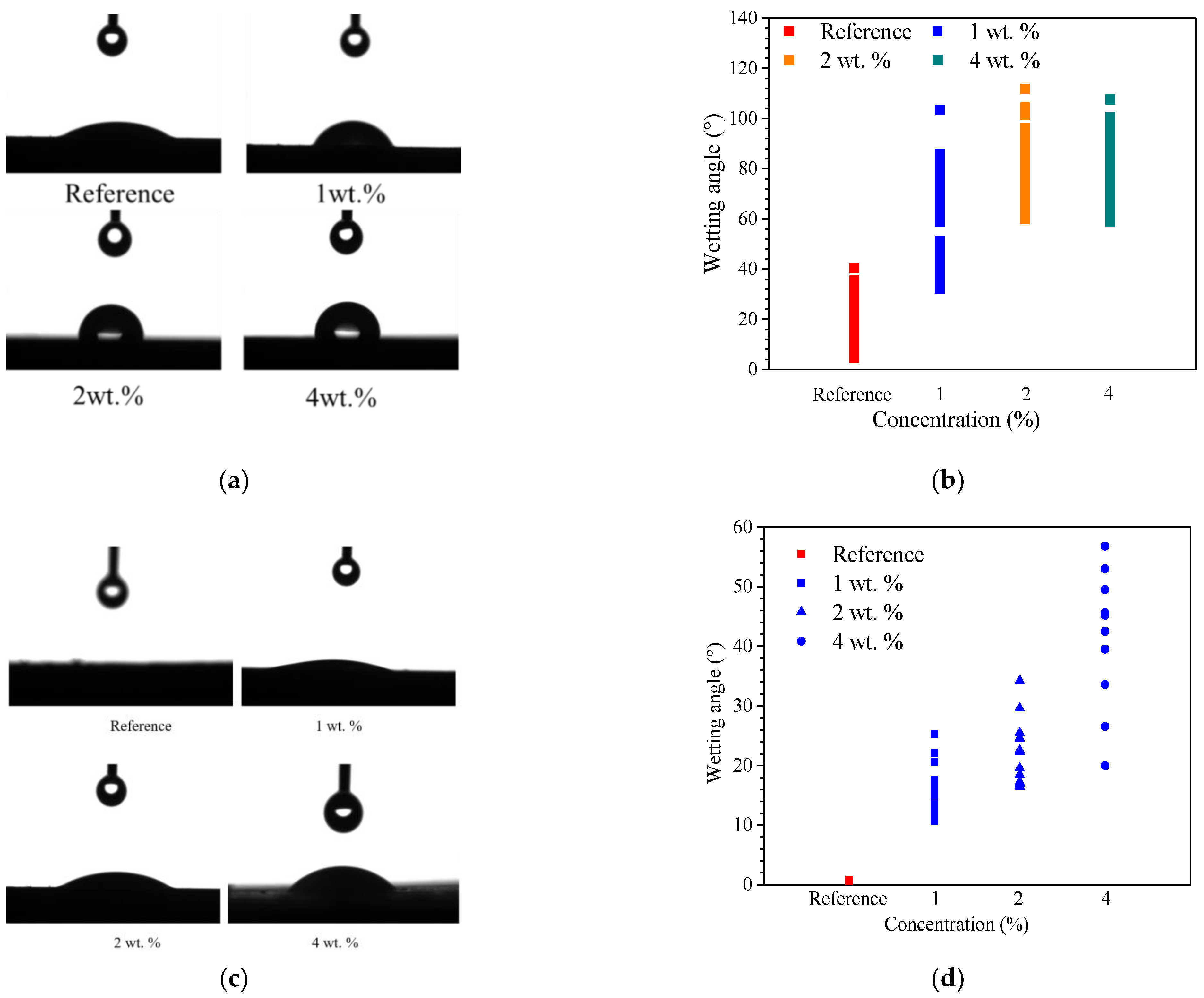
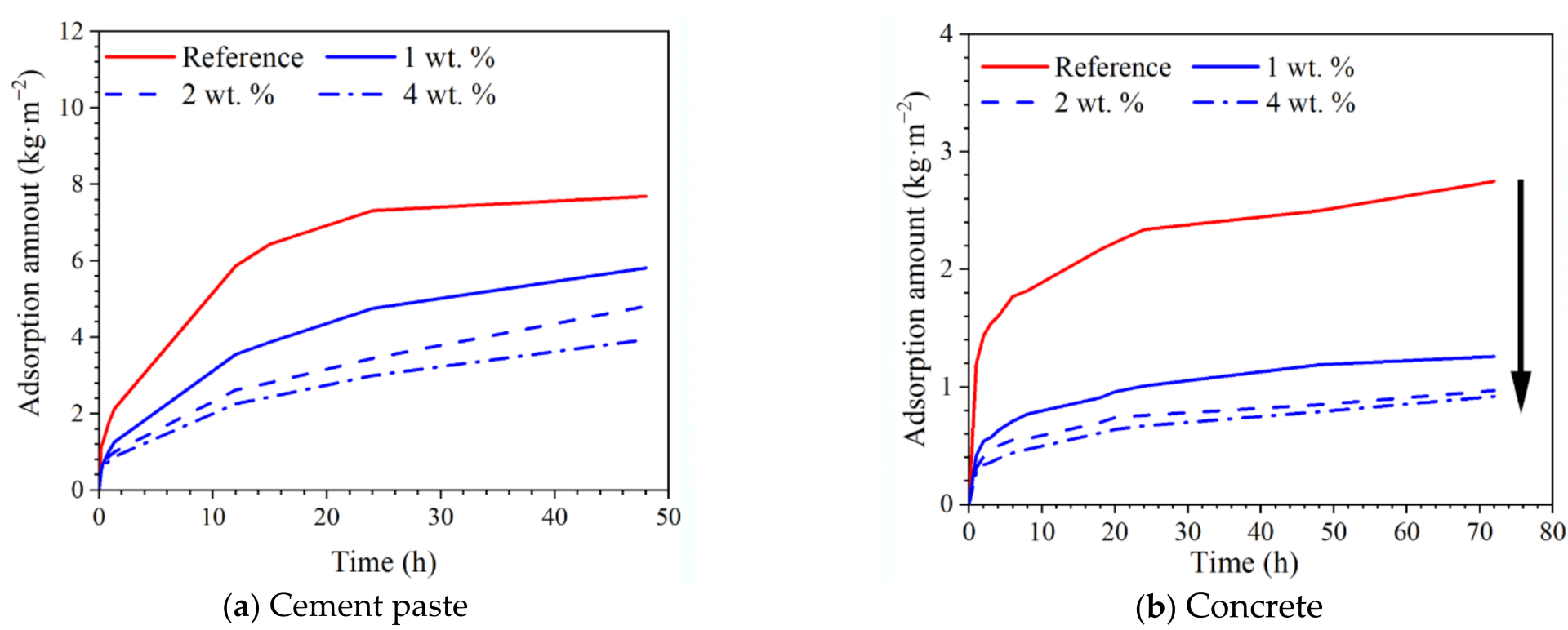
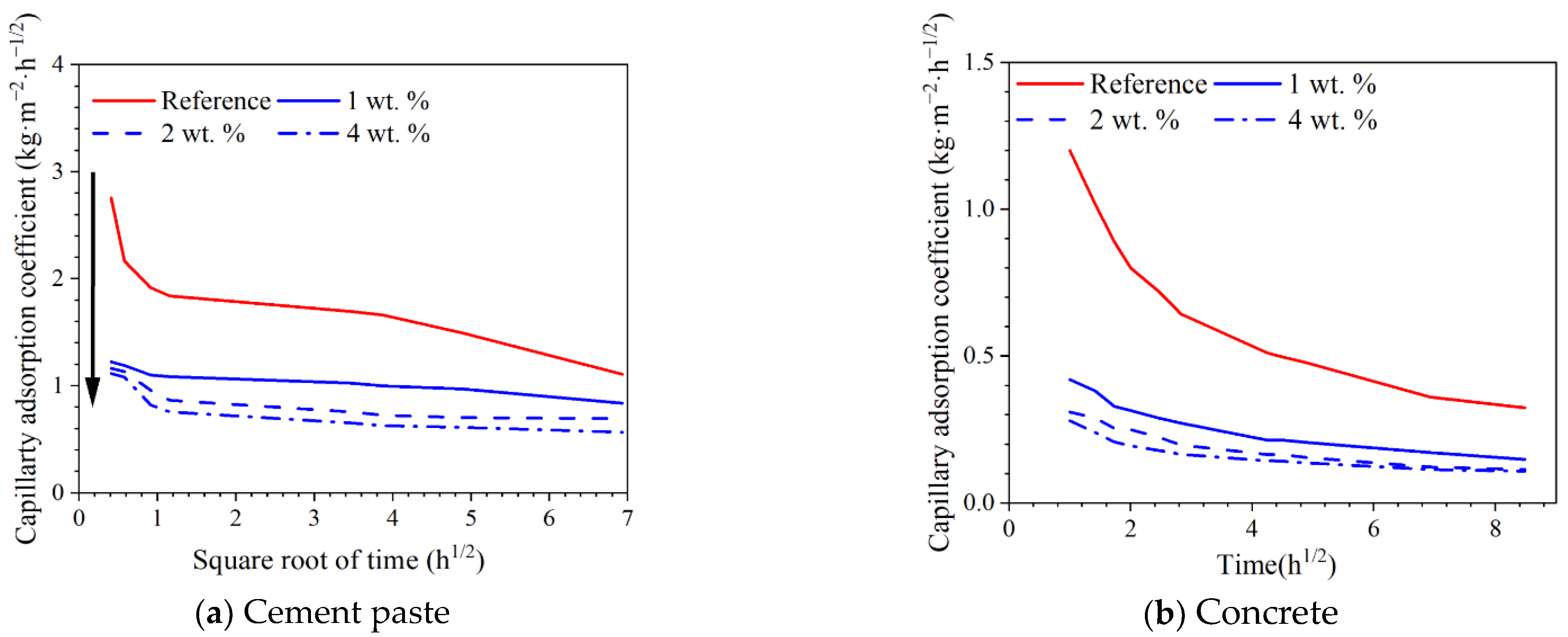

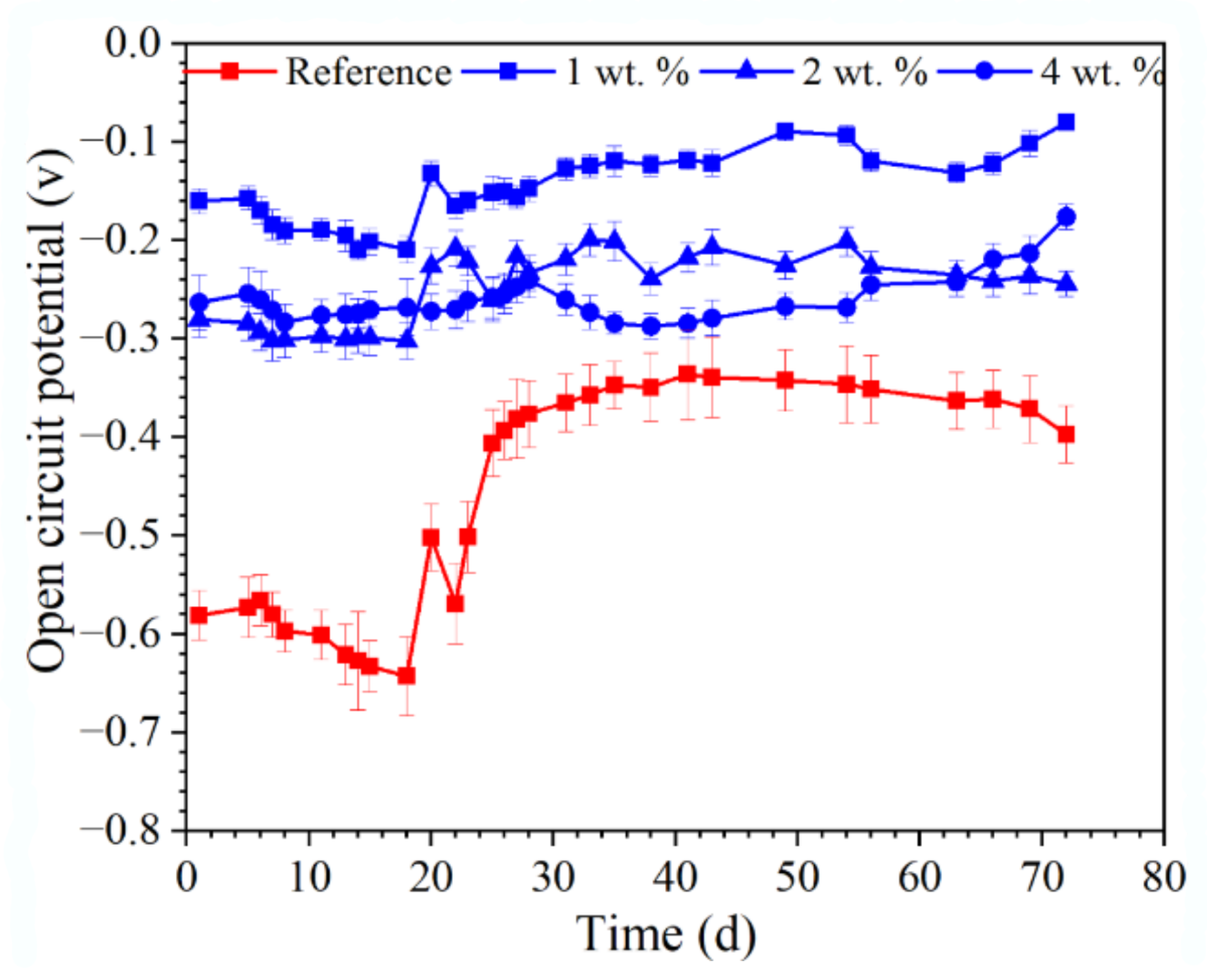
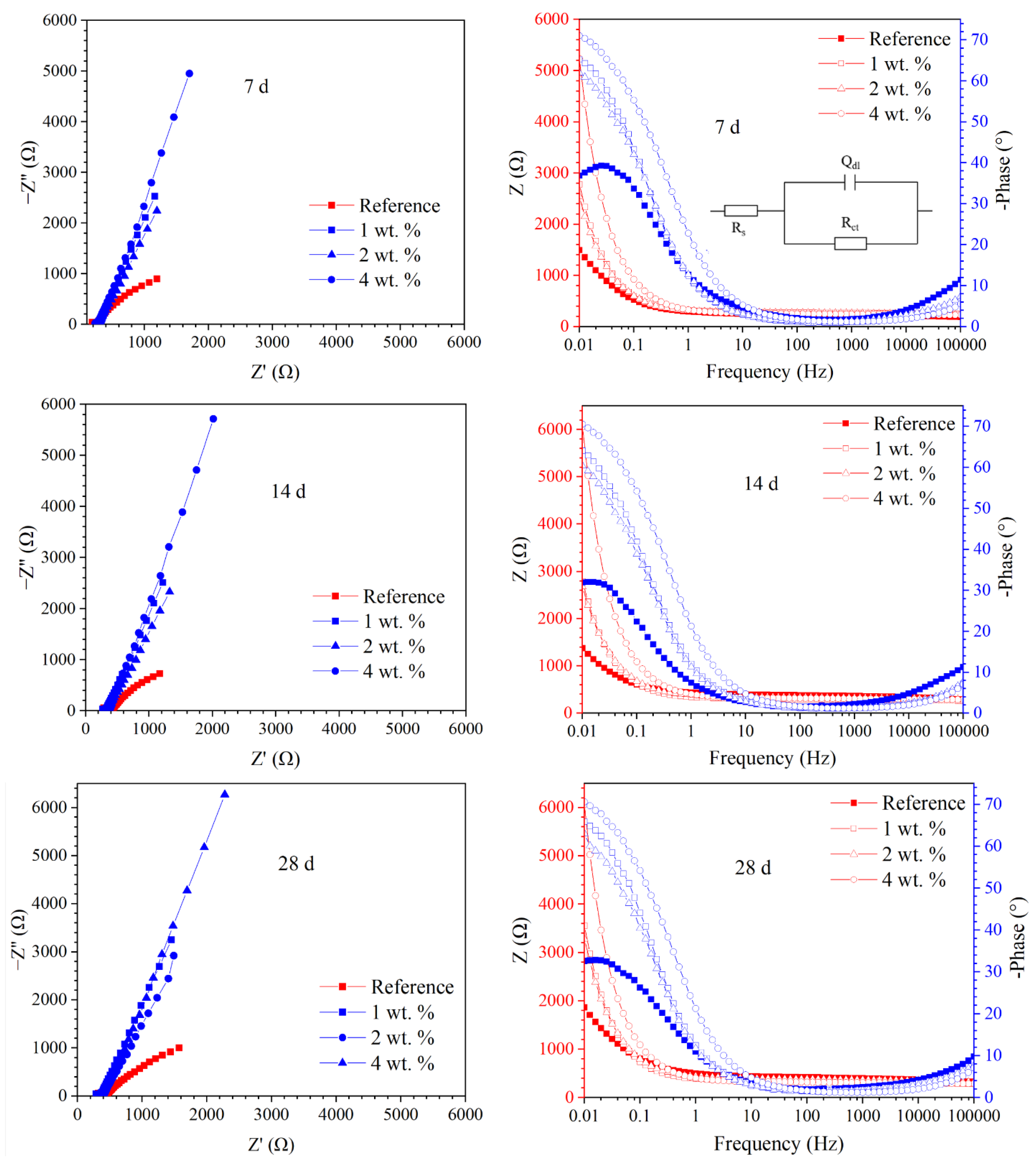

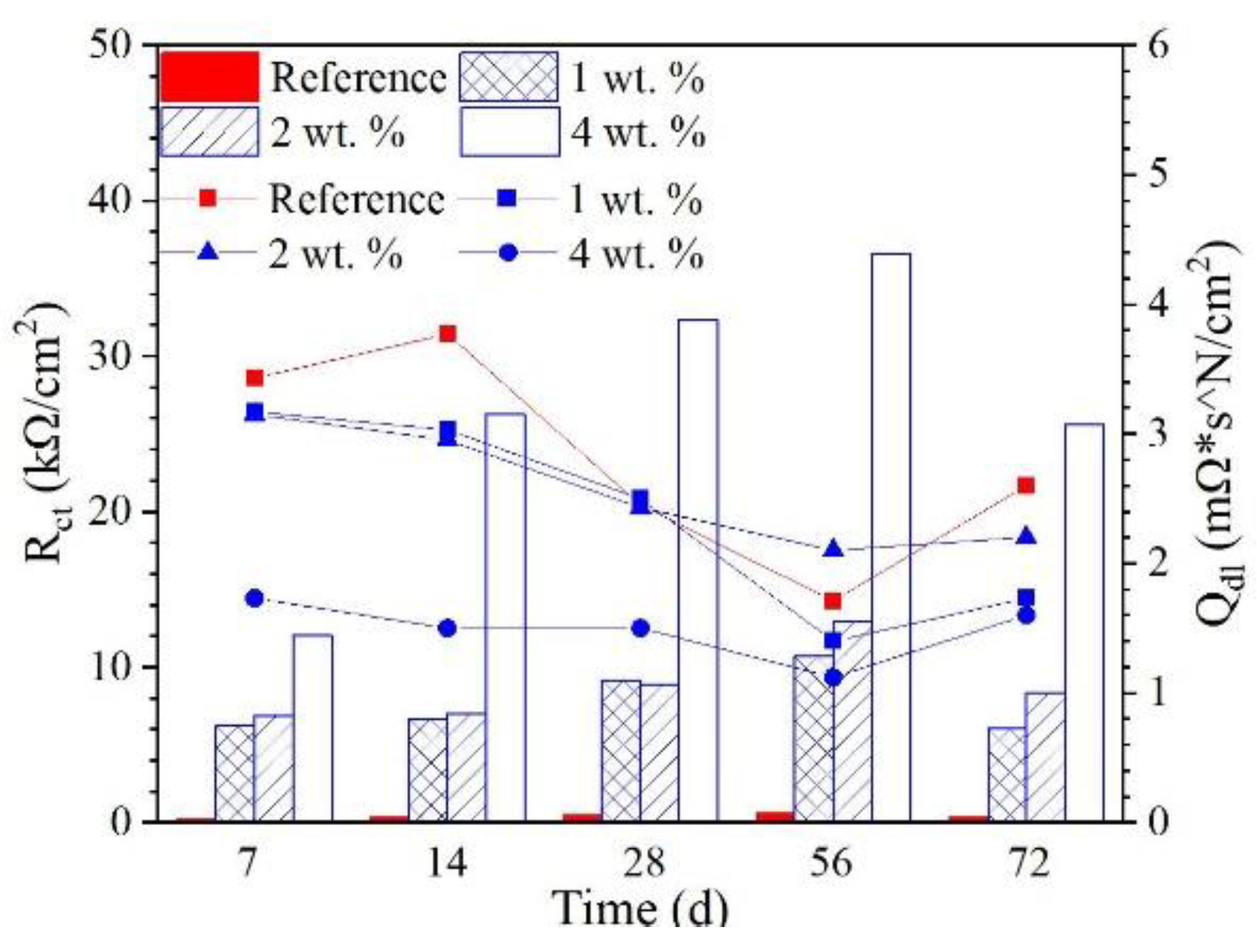
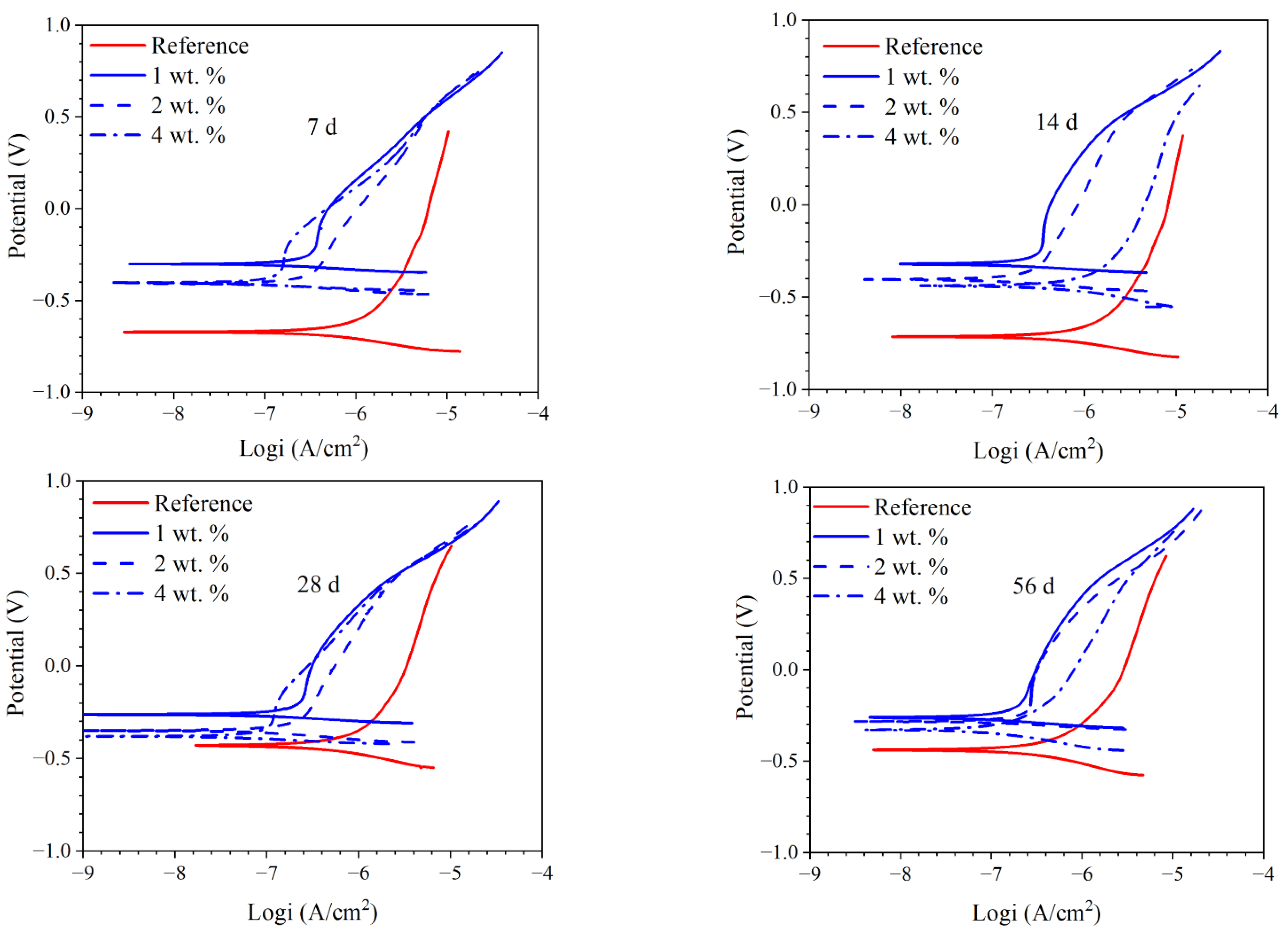

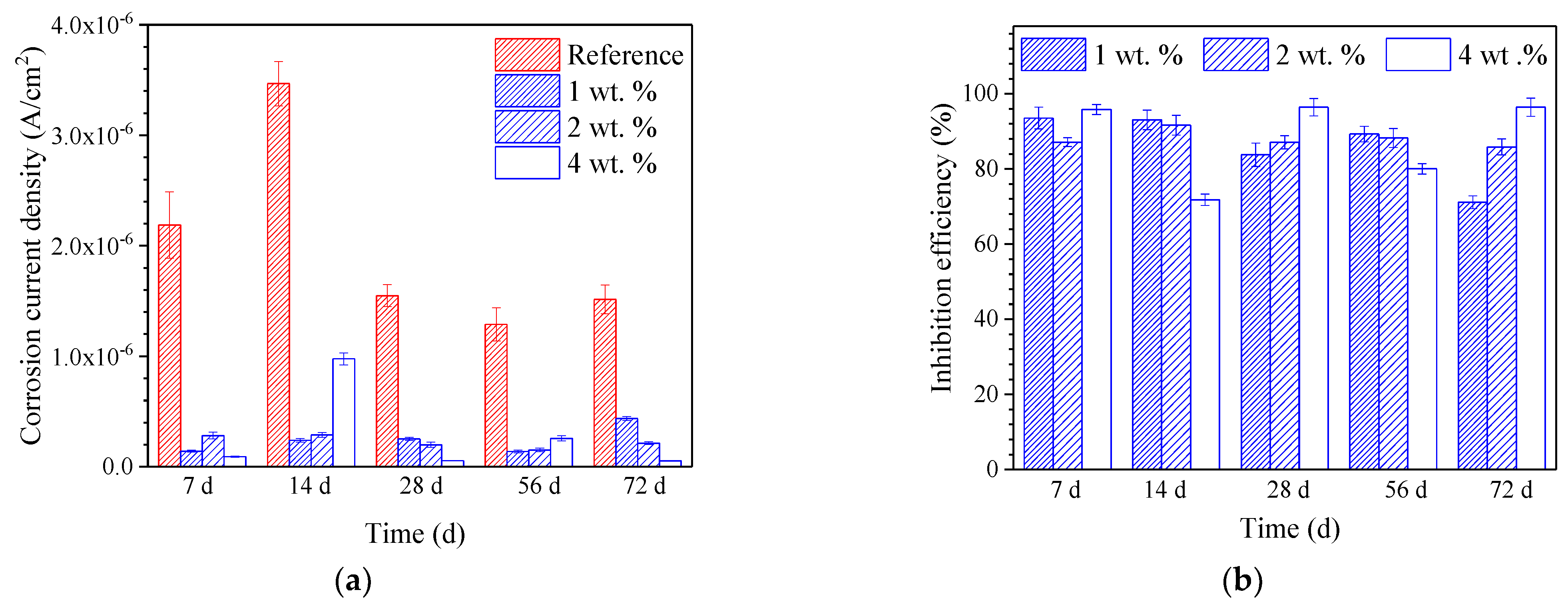
| Composition | SiO2 | CaO | Al2O3 | Fe2O3 | SO3 | MgO | K2O | Na2O | Others | LOI * |
|---|---|---|---|---|---|---|---|---|---|---|
| Content | 21.51 | 58.05 | 7.37 | 4.16 | 2.85 | 1.76 | 0.51 | 0.16 | 1.71 | 1.92 |
| Mud Content (%) | Apparent Density (kg/m3) | Loose Bulk Density (kg/m3) | Close Packing Density (kg/m3) | Air Void (%) | Fineness Modulus |
|---|---|---|---|---|---|
| 1.5 | 2610 | 1490 | 1557 | 40 | 2.6 |
| Screen Size (mm) | 10.000 | 5.000 | 2.500 | 1.250 | 0.630 | 0.315 | 0.160 |
| Total residue (%) | 0.0 | 0.5 | 10.9 | 32.7 | 55.8 | 74.7 | 88.4 |
| Mud Content (%) | Apparent Density (kg/m3) | Loose Bulk Density (kg/m3) | Close Packing Density (kg/m3) | Air Void (%) |
|---|---|---|---|---|
| 0.3 | 2733 | 1405 | 1518 | 9.1 |
| Screen Size (mm) | 16.000 | 10.000 | 5.000 | 2.5000 |
| Total residue (%) | 0 | 7.4 | 98.7 | 100 |
| Element | C | Si | Mn | S | P | Fe |
| Content | 0.15 | 0.29 | 0.56 | 0.04 | 0.03 | 98.93 |
| Cement (kg/m3) | Fine Aggregates (kg/m3) | Coarse Aggregates (kg/m3) | Water (kg/m3) | Inhibitor (kg/m3) | |
|---|---|---|---|---|---|
| CEM-0 | 340 | 1050 | 780 | 170 | 0 |
| CEM-1 | 340 | 1050 | 780 | 166.6 | 3.4 |
| CEM-2 | 340 | 1050 | 780 | 163.2 | 6.8 |
| CEM-4 | 340 | 1050 | 780 | 156.4 | 13.6 |
| <20 nm (%) | 20 nm–50 nm (%) | 50 nm–100 nm (%) | >100 nm (%) | |
|---|---|---|---|---|
| Reference | 5.05 | 4.11 | 11.39 | 4.51 |
| 1 wt.% | 5.62 | 4.85 | 11.63 | 2.63 |
| 2 wt.% | 5.27 | 5.32 | 10.93 | 1.46 |
| 4 wt.% | 5.30 | 6.16 | 9.86 | 1.16 |
| Type of Corrosion Inhibitor | NaCl | Inhibitor | Time/d | Efficiency/% |
|---|---|---|---|---|
| Reed leaves extract | 3.5 wt.% | 0.5 wt.% | 180 | 77.0 |
| Ginger extract | 8 wt.% | 4 wt.% | 60 | 40.9 |
| Ca(NO2)2 | 8 wt.% | 4 wt.% | 60 | 25.7 |
| Kelp extract | 8 wt.% | 4 wt.% | 60 | 52.8 |
| EG/AgNPs | Natural seawater | 5 wt.% | 90 | 82.6 |
| Rice husk ash | 5 wt.% | 20 wt.% | 40 | 85.0 |
| Triethanolamine | 3.5 wt.% | 1 wt.% | 28 | 64.2 |
| Triethanolamine + Ca(NO2)2 | 3.5 wt.% | 1 wt.% | 28 | 90.1 |
| Guanidine | 1 M | 0.5 M | 30 | 77.5 |
| 1,6-Hexamethylenediamine | 1 M | 1 M | 30 | 84.5 |
| 3-Aminopropyltriethoxysilane | 1 M | 1 M | 30 | 62.6 |
| Ethanolamine | 3.5 wt.% | 5 L/m3 | 270 | 95.0 |
| Monoflurophosphate | 3.5% | 2% | 270 | 50.0 |
| This study | 3.5% | 4% | 72 | 96.0 |
Publisher’s Note: MDPI stays neutral with regard to jurisdictional claims in published maps and institutional affiliations. |
© 2022 by the authors. Licensee MDPI, Basel, Switzerland. This article is an open access article distributed under the terms and conditions of the Creative Commons Attribution (CC BY) license (https://creativecommons.org/licenses/by/4.0/).
Share and Cite
Huang, J.; Hu, J.; Cai, J.; Huang, H.; Wei, J.; Yu, Q. Inhibition Effect of Hydrophobic Functional Organic Corrosion Inhibitor in Reinforced Concrete. Materials 2022, 15, 7124. https://doi.org/10.3390/ma15207124
Huang J, Hu J, Cai J, Huang H, Wei J, Yu Q. Inhibition Effect of Hydrophobic Functional Organic Corrosion Inhibitor in Reinforced Concrete. Materials. 2022; 15(20):7124. https://doi.org/10.3390/ma15207124
Chicago/Turabian StyleHuang, Jinzhen, Jie Hu, Jinshun Cai, Haoliang Huang, Jiangxiong Wei, and Qijun Yu. 2022. "Inhibition Effect of Hydrophobic Functional Organic Corrosion Inhibitor in Reinforced Concrete" Materials 15, no. 20: 7124. https://doi.org/10.3390/ma15207124
APA StyleHuang, J., Hu, J., Cai, J., Huang, H., Wei, J., & Yu, Q. (2022). Inhibition Effect of Hydrophobic Functional Organic Corrosion Inhibitor in Reinforced Concrete. Materials, 15(20), 7124. https://doi.org/10.3390/ma15207124








